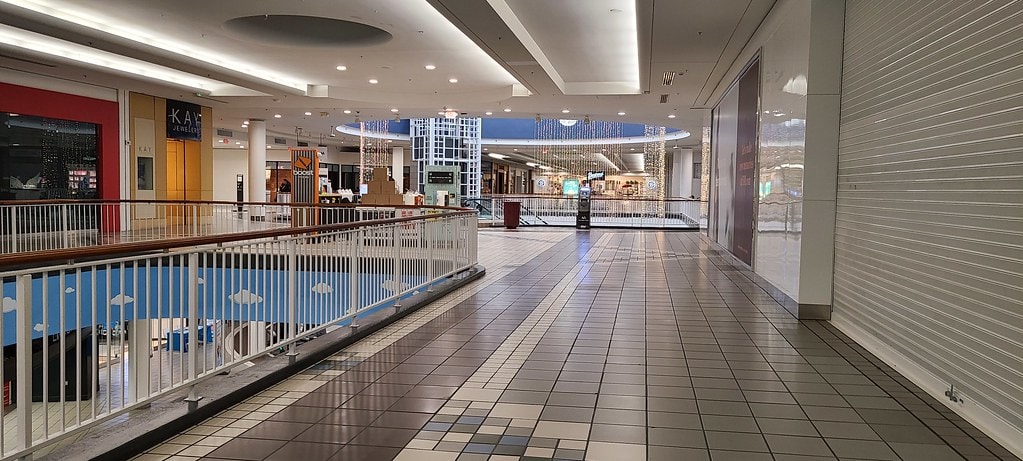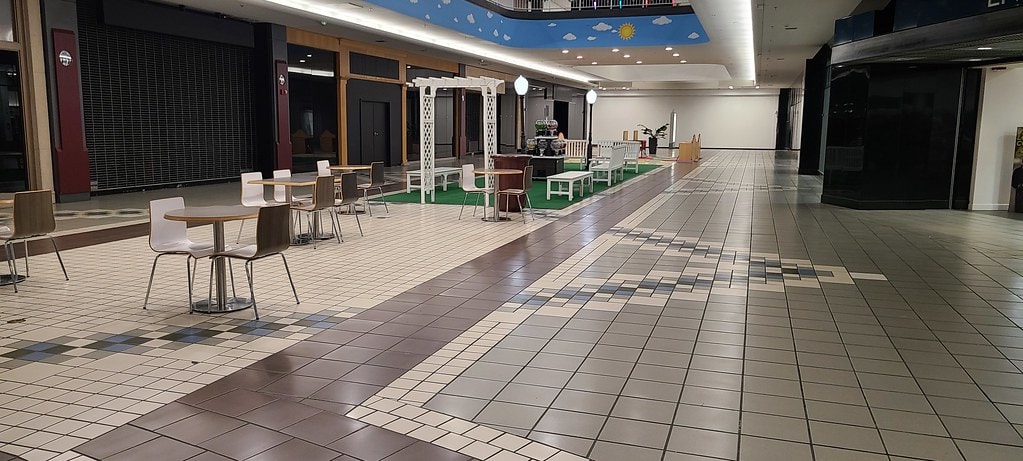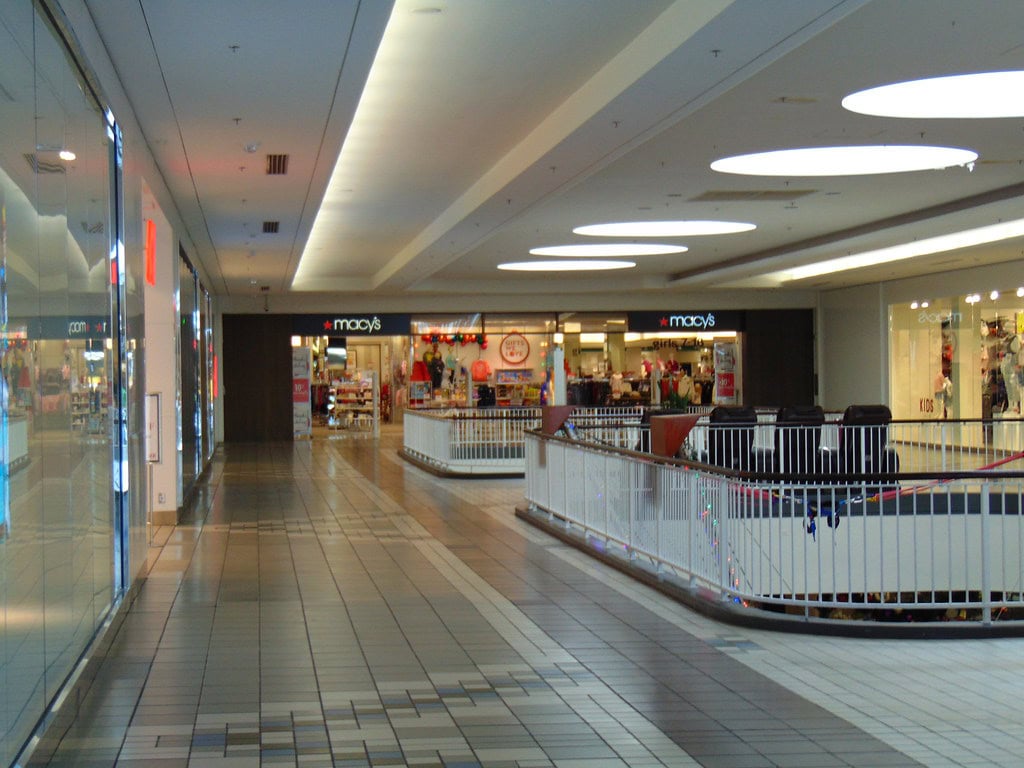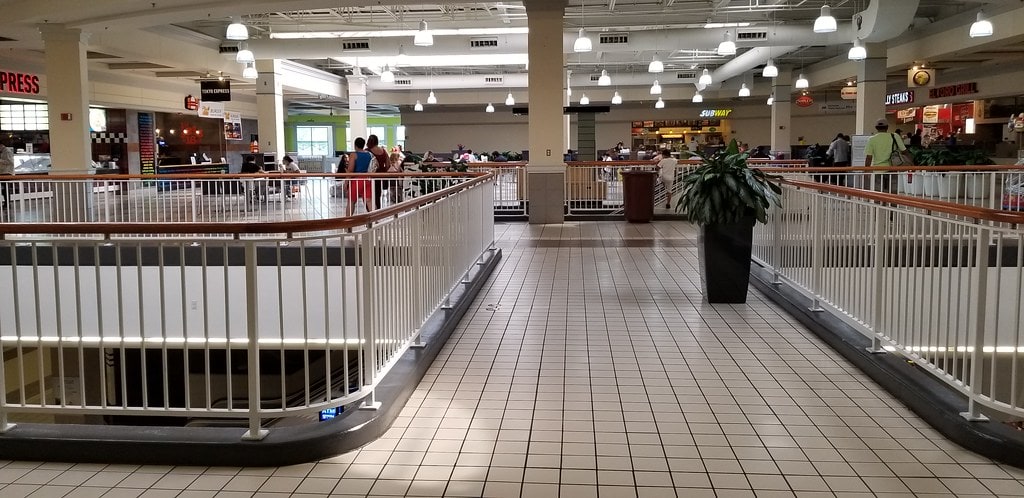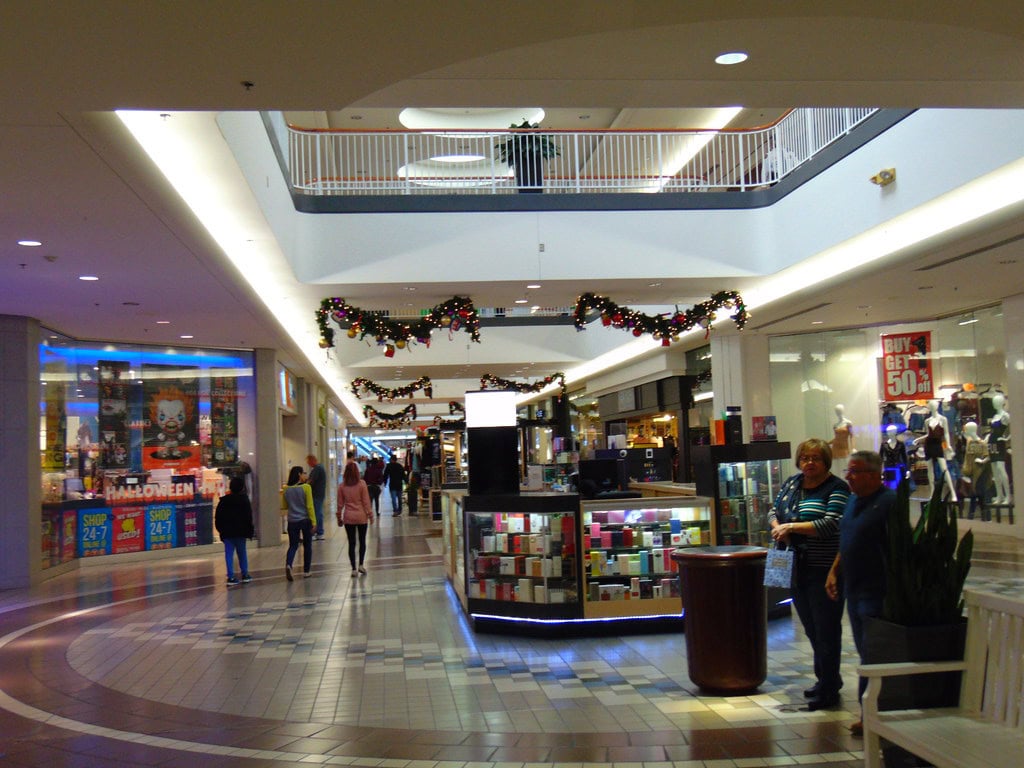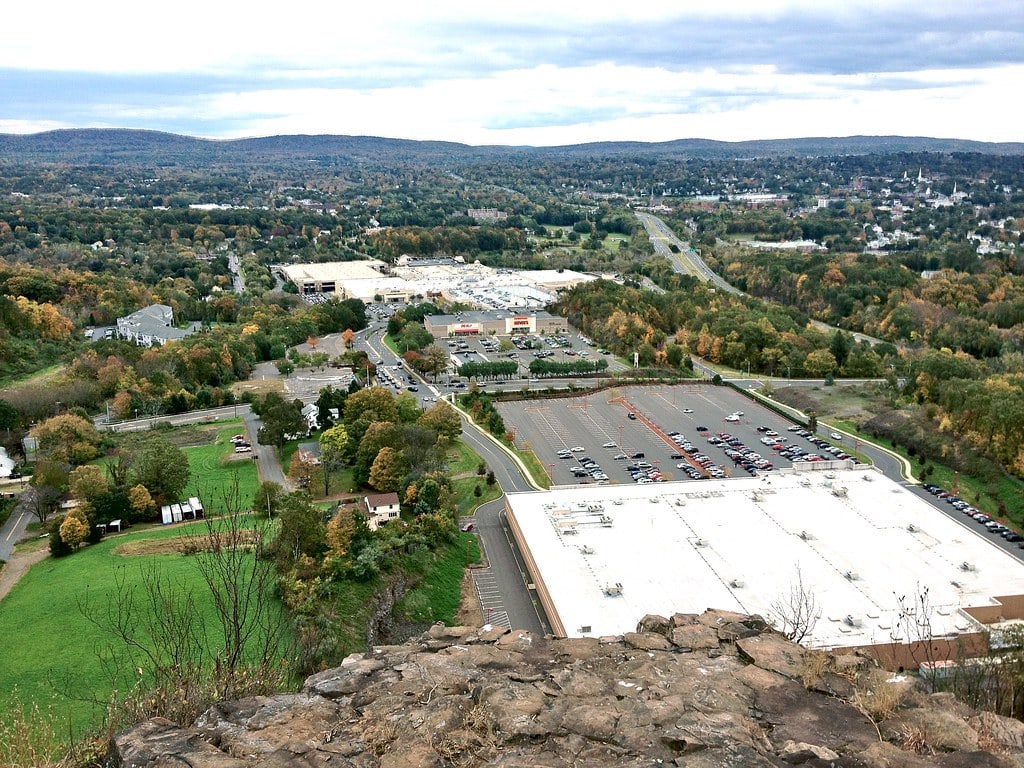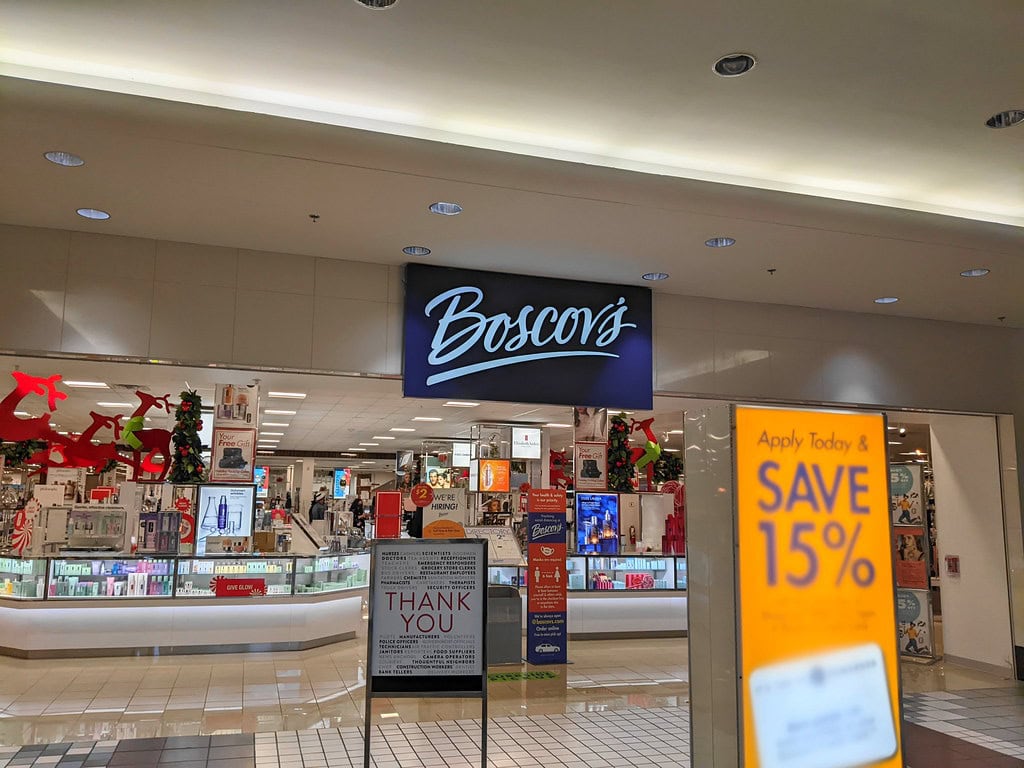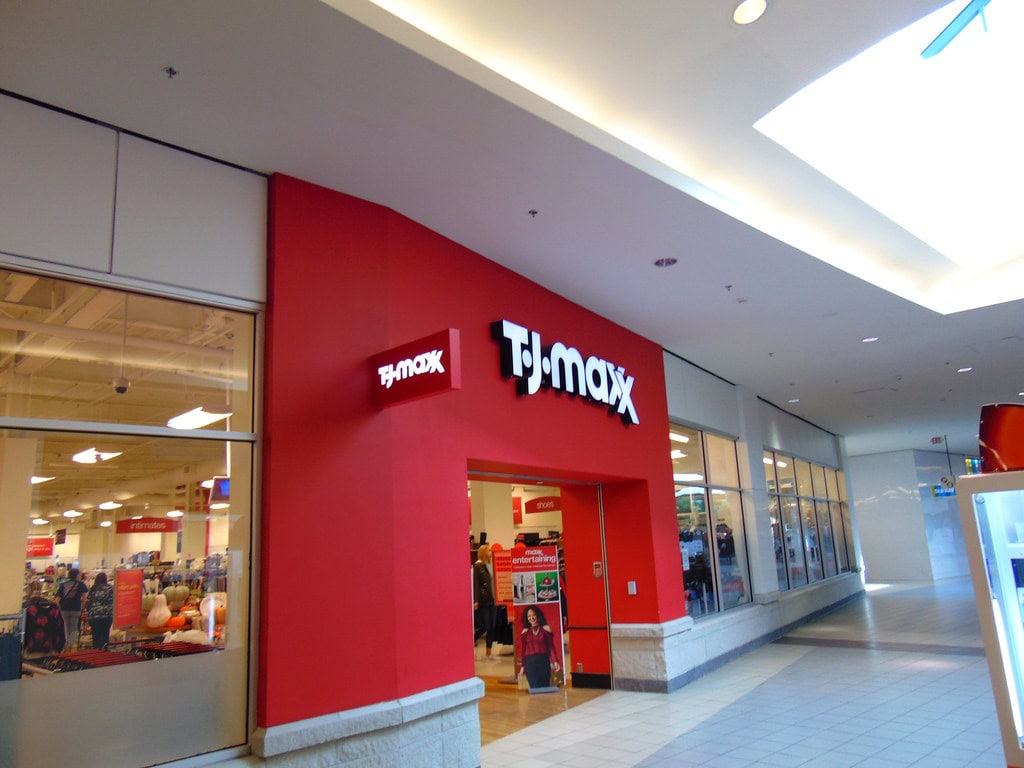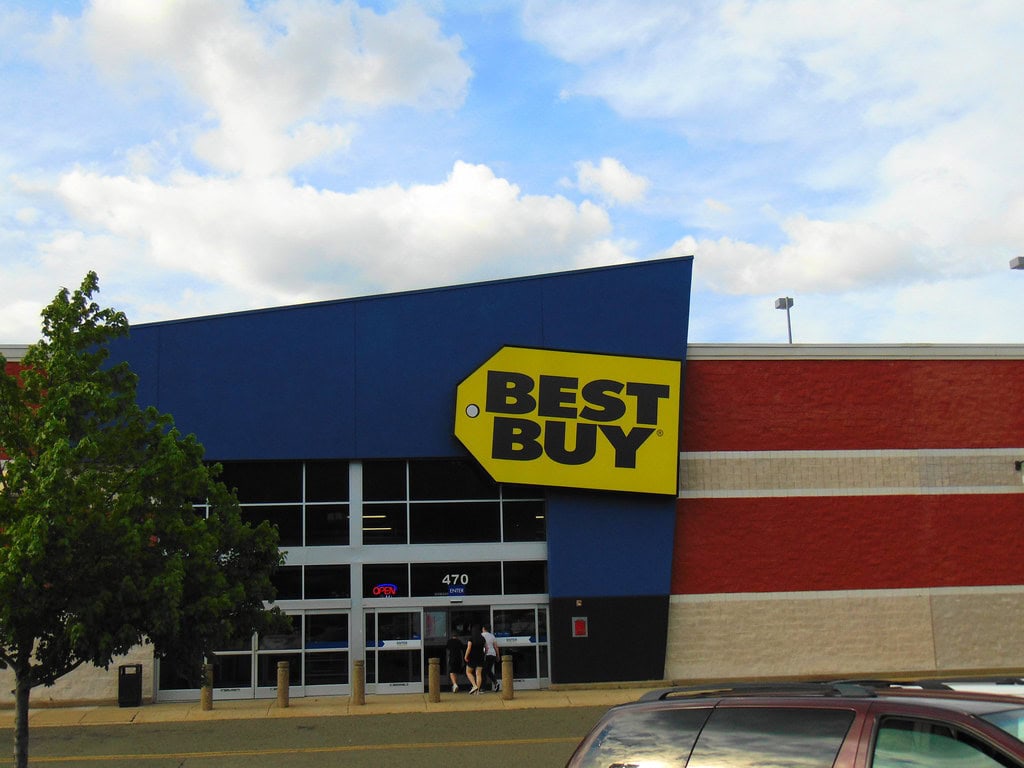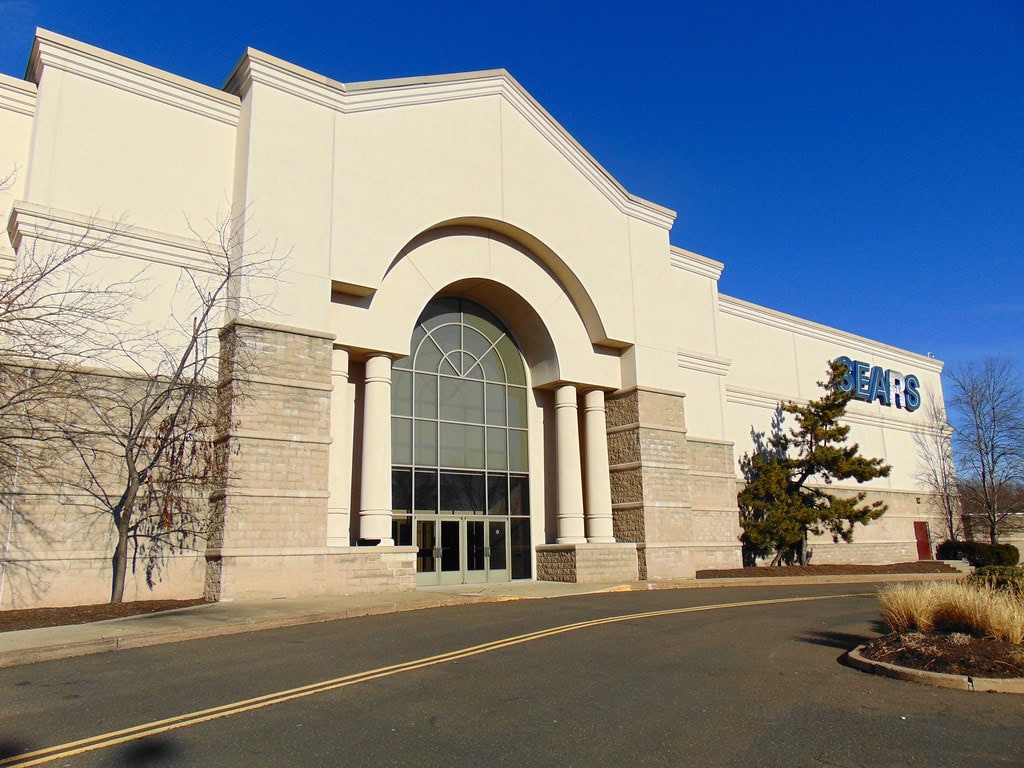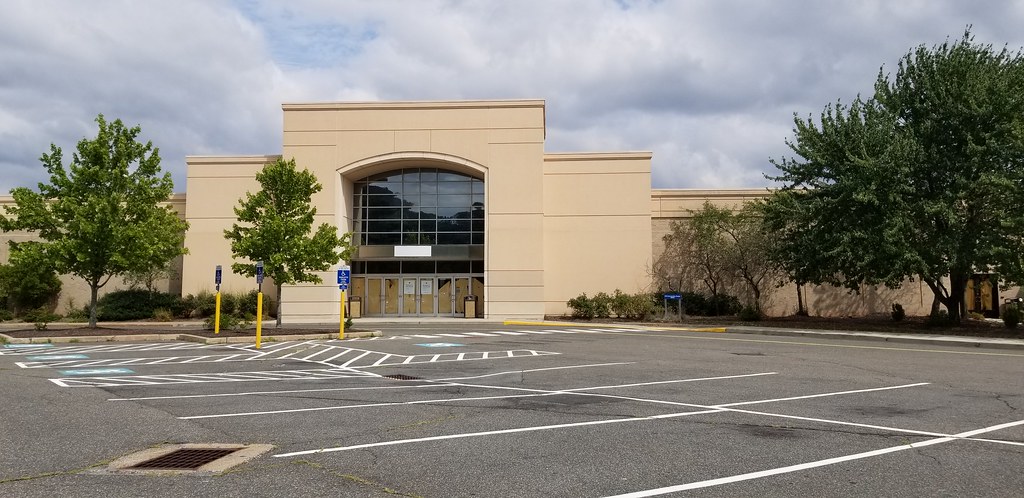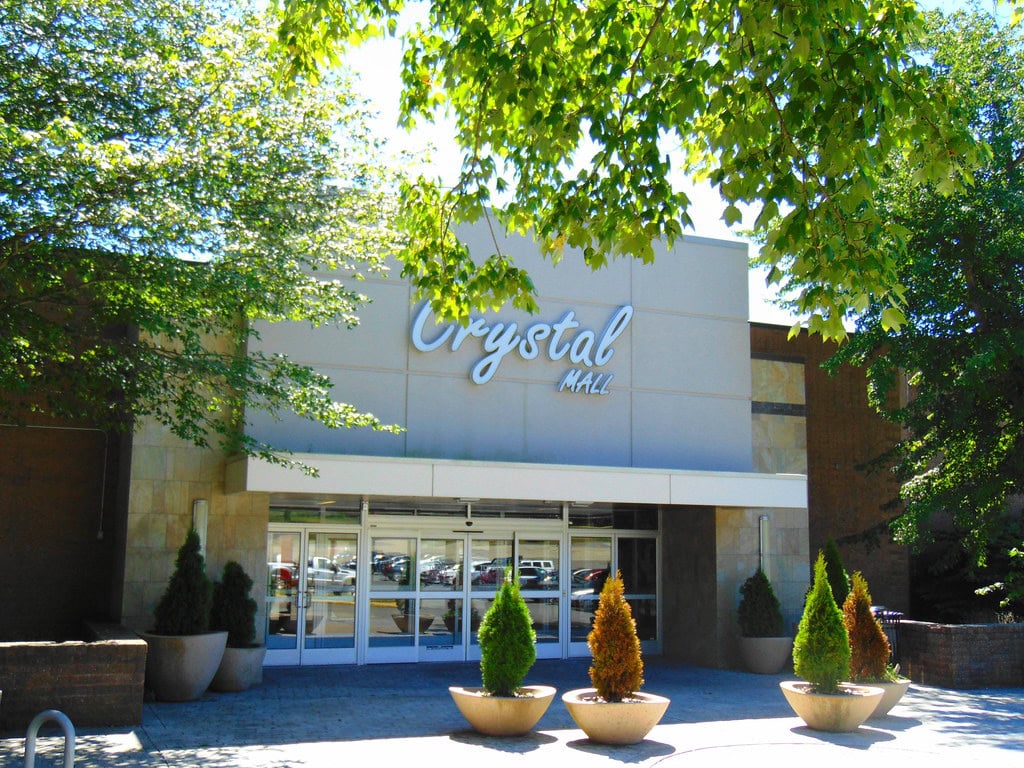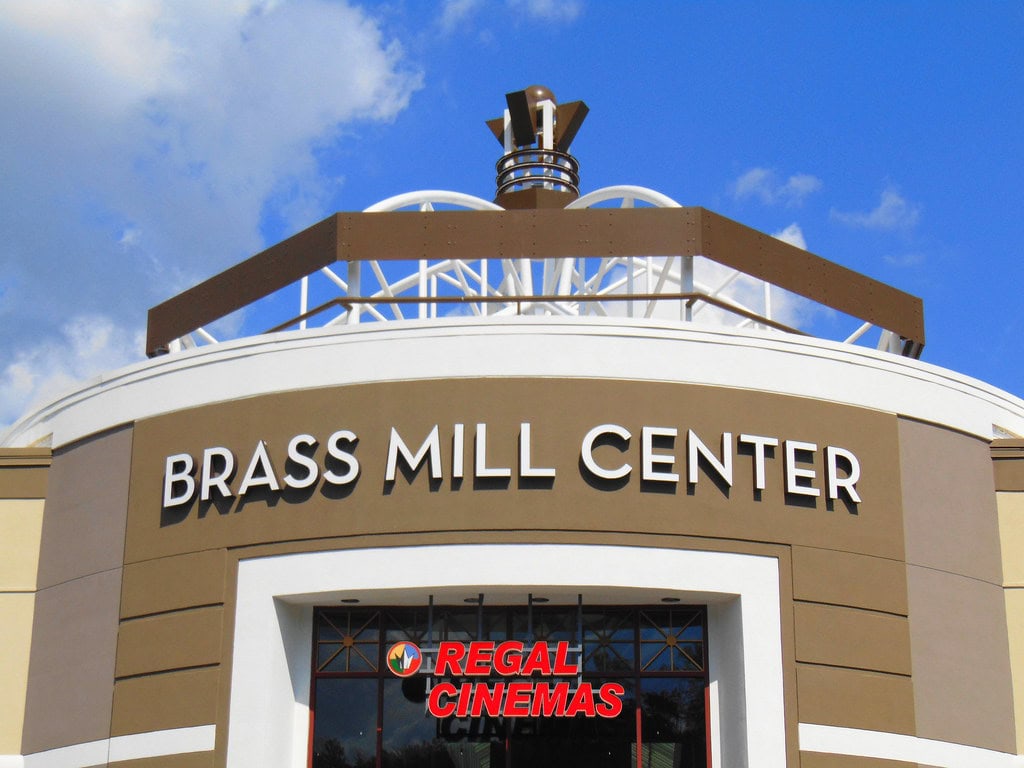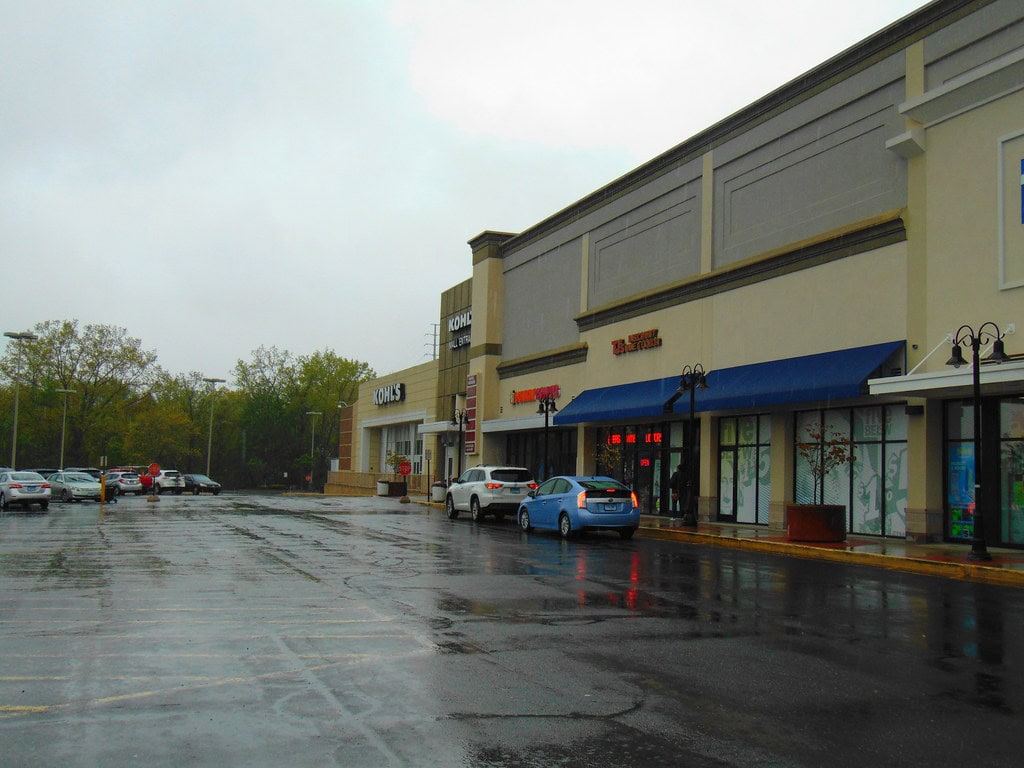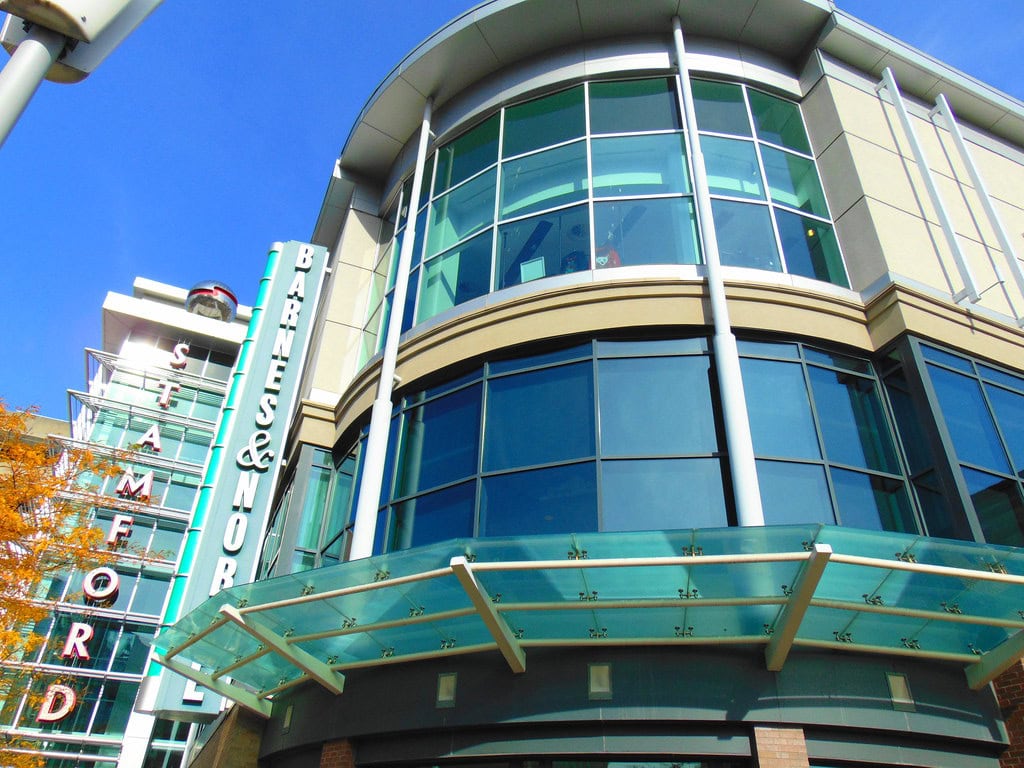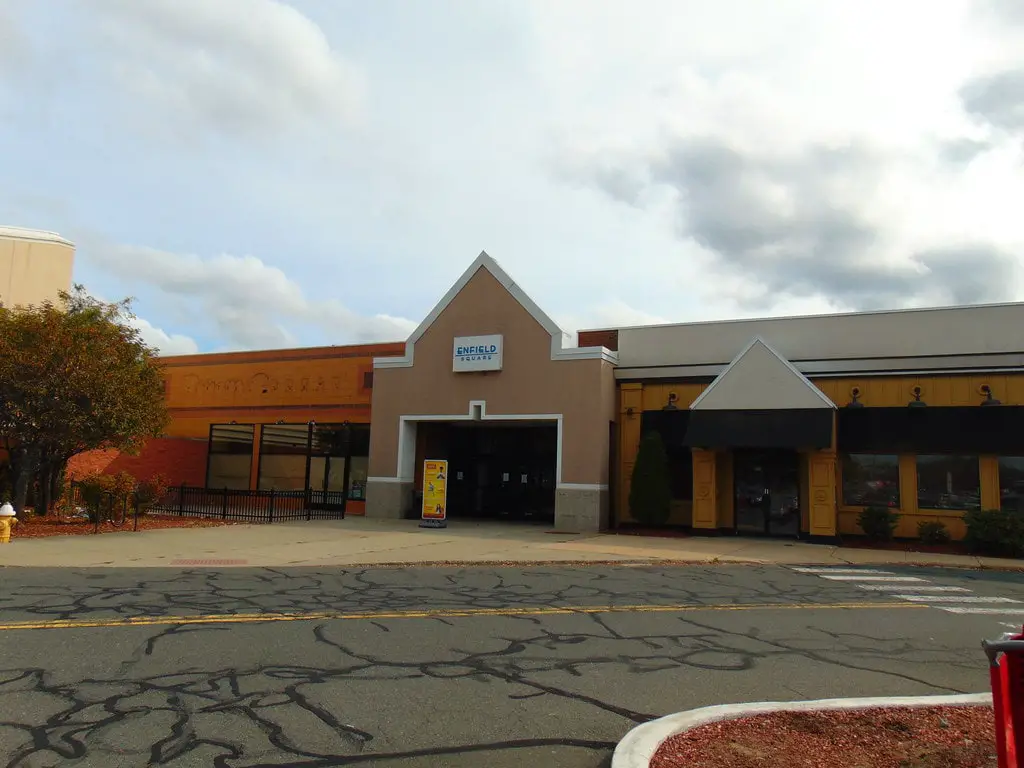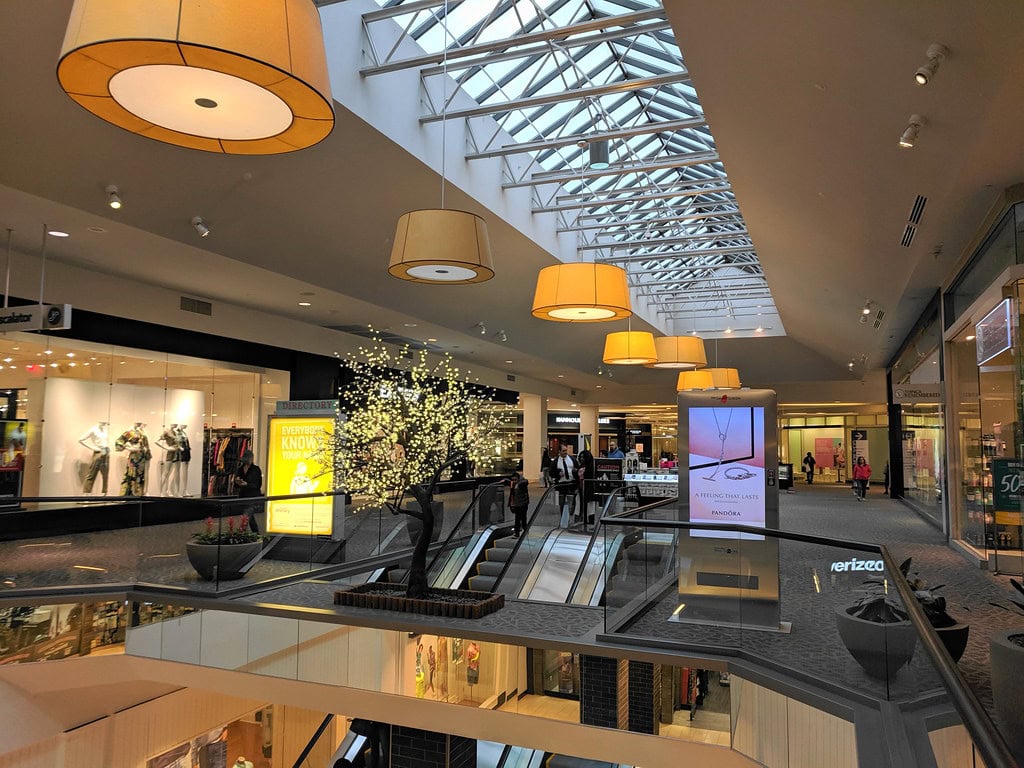Meriden Mall opened in 1971 on Lewis Avenue, just off I‑691 in central Connecticut.
Built by The May Department Stores Company, it launched with two anchor tenants, G. Fox and JCPenney, and a two-level layout shaped like a dumbbell.
The interior held a Friendly's, a Radio Shack, a tobacco shop, and a travel agency. There was an inclined ramp‑escalator at the center court and restaurants inside both anchor stores.
A second wing arrived in 1993, adding Sears and a food court.
By the end of the decade, the mall had grown into a cross-shaped layout with four anchors and a new parking deck along Lewis Avenue.
Lord & Taylor moved in during a $38 million renovation, but left by 2005.
Ownership changed in 2020. Macy's, Sears, and Dick's all exited.
By 2025, more than 50 storefronts sat empty, and Boscov's and TJ Maxx were the only anchors still open.
A New Mall for Meriden (1971-1992)
When Meriden Square opened in 1971, the name matched the structure: simple, enclosed, and straightforward.
The mall sat between residential neighborhoods and the I‑691 connector, with a two-level interior anchored by JCPenney and G. Fox, both operated by The May Department Stores Company.
Each anchor had its own restaurant. Friendly's was the only full-service dining option elsewhere in the mall.
The central incline escalator marked the junction where traffic from either anchor converged.
Inside, national chains shared space with Connecticut-based tenants.
Spencer Gifts, Waldenbooks, Radio Shack, and Hickory Farms filled standard inline spaces, alongside Mall Liquors and a tobacco shop.
A piano and organ store called Keyboard sat near Chess King and a Singer sewing machine retailer.
CVS operated a drugstore location, and there was a C.B. Perkins tobacconist with a storefront facing the main concourse.
The mall was heated and air-conditioned, with drop ceilings and terrazzo flooring.
The layout followed a basic dumbbell shape, with wide corridors and glass storefronts set in aluminum frames.
Parking was surface-level, with access from Lewis Avenue and Chamberlain Highway.
Holiday traffic often backed up at both entrances. Tenants handled their own signage and fixtures.
Apart from anchor stores, leases typically included front-facing displays and minimal storage space.
No food court existed yet, and snack counters were built into individual storefronts.
Growth, Food Courts, and Filene's (1993-1996)
By 1993, a second wing extended the floorplan past the original layout, turning the structure into a T-shaped mall with three major anchors.
Sears arrived as part of that renovation with a new two-story corridor connecting the anchor to the rest of the mall.
The food court was added during the same project, built near the Sears end of the wing, and offered a mix of national and regional food vendors.
G. Fox rebranded that same year following the May Company's acquisition of Filene's.
The former G. Fox space converted to Filene's, retaining its layout but updating store branding and interior signage.
Department listings and wayfinding directories were revised to reflect the change.
Fixtures and counters remained largely in place, and escalator placement did not shift.
Tenant mix expanded with the renovation.
The mall introduced newer chain retailers alongside established names, offering electronics, apparel, and home goods across the new square footage.
Walkways were resurfaced with updated tiling, and skylights were installed over select interior sections.
Daily traffic increased after the addition of Sears, which brought more utility-focused shopping into the mix.
While the food court pulled visitors toward the new wing, the original section remained active with legacy tenants.
Anchor entrances opened independently to the parking lot, which remained unchanged except for striping updates near the new wing.
Westfield's Turn and Lord & Taylor's Rise and Fall (1997-2005)
In 1997, the Westfield Group purchased the mall and began work on another large-scale expansion.
That year, plans were announced to increase floor area by more than 147,000 square feet, with a focus on higher-end branding.
The project included 30 new retail spaces, a fourth anchor location, and a multistory garage added near Sears.
When construction finished in 1999, the layout had shifted again - from a T to a full cross, with Lord & Taylor occupying the new anchor wing.
Storefront glass was replaced in many of the older areas, and lighting upgrades were added in both concourses and open courts.
The original center escalator remained in place, but signage and wayfinding materials were replaced mall-wide.
The garage structure offered direct access to Sears and JCPenney and supported the increased store count.
Lord & Taylor stayed for five years. The location closed in 2004 during a corporate repositioning that affected several properties.
Westfield filled the vacancy with Dick's Sporting Goods.
Retailers during this period included Gap, Foot Locker, American Eagle, Victoria's Secret, and Yankee Candle.
Mall traffic remained steady, especially on weekends, with seasonal increases tied to holiday promotions and school schedules.
Brand Changes, Regional Adjustments (2006-2014)
In 2006, Filene's officially rebranded as Macy's, completing a broader merger between May Company and Federated Department Stores.
The Meriden Mall location kept its existing structure.
JCPenney left in 2014. Later that year, Boscov's announced plans to replace it.
Their buildout was more extensive than earlier replacements, requiring a full remodel of the old anchor space.
The exterior was refaced, and interior walls were stripped and rebuilt to fit Boscov's multi-department layout.
The store opened in November 2015 and marked Boscov's first entry into both Connecticut and New England.
The overall layout did not change, but the retail environment grew quieter during weekdays.
Major traffic continued to cluster around anchor openings and food vendors.
Vacancy and Ownership Transfer (2015-2020)
Sears announced its exit from Meriden Mall in November 2018. The anchor space, which had been added in 1993, went dark the following year.
Macy's followed with its own departure in January 2020, citing a revised national strategy focused on higher-performing locations.
Unibail-Rodamco-Westfield sold the mall to Namdar Realty Group in May 2020.
Namdar and Mason Asset Management assumed ownership on June 1, 2020. No capital improvements were announced during the transition.
Leasing, operations, and security continued under in-house oversight.
In September 2021, Best Buy announced it would close its location at the mall.
The former electronics anchor, which had operated near the Macy's footprint, shut its doors by year's end.
Discussions of replacement tenants were reported but not confirmed.
On October 4, 2021, Yale New Haven Health purchased the former Macy's building.
Plans called for the structure to be demolished and replaced with a medical facility, though construction had not begun by early 2025.
By the close of 2021, three major anchor spaces were empty.
The mall still housed Boscov's, Dick's Sporting Goods, and TJ Maxx, along with national retailers like Bath & Body Works and Spencer's.
Traffic declined steadily outside of holiday periods.
Rebuilding or Replacing? (2021-2025)
In early 2024, more tenants left. Forever 21 Red announced its permanent closure by March 31.
One month later, Dick's Sporting Goods confirmed it would exit the mall by April 20.
Those two departures reduced the number of open anchors to two: Boscov's and TJ Maxx.
Smaller retailers began leaving as well. By June 2025, Spencer's Gifts, Nail Box salon, and Imperial Gaming & Collectibles had all shut down.
Over 50 storefronts sat vacant.
A few new businesses opened or announced plans to move in. In March 2025, Moz Pizza & Grinders confirmed a second location inside the food court.
Adventure Palace, an indoor children's activity park, began renovations in the former Best Buy space, with an opening planned for late summer or early fall.
Total Wireless by Verizon and Abuelo's Exclusive Coffee were also added to the tenant roster that spring.
Santos Kitchen, a multicultural restaurant offering Hispanic cuisine, confirmed its food court location in July 2025.
The storefront was under construction, with an opening planned for the fall.
Yale New Haven's project on the former Macy's site remained in planning as of mid-2025.
The rest of the structure held its 1990s configuration. Anchor spaces stayed intact. Some corridors were quiet.
New dining options brought limited traffic back to the food court, while open-air parking remained unchanged.


